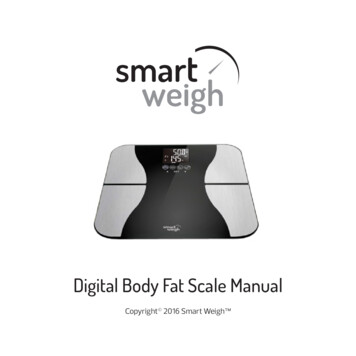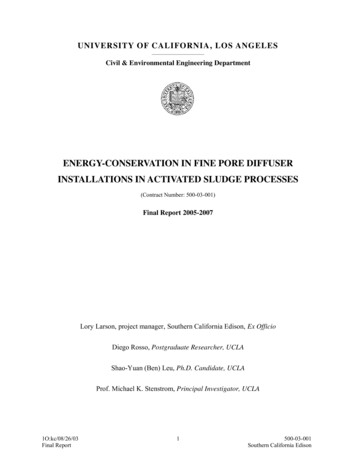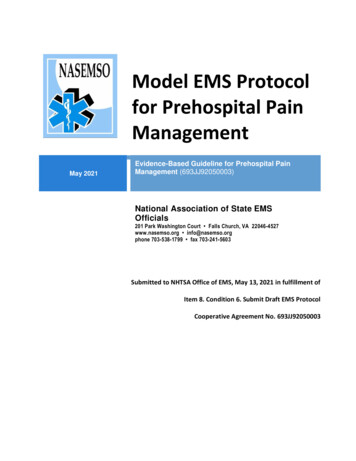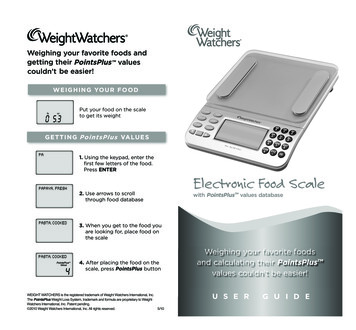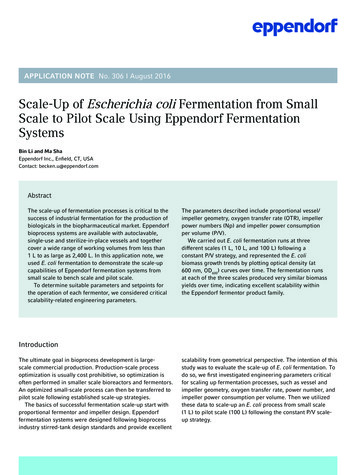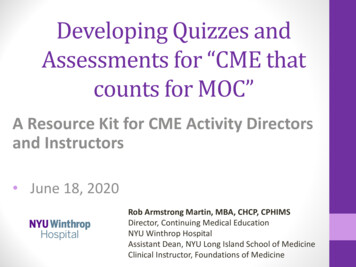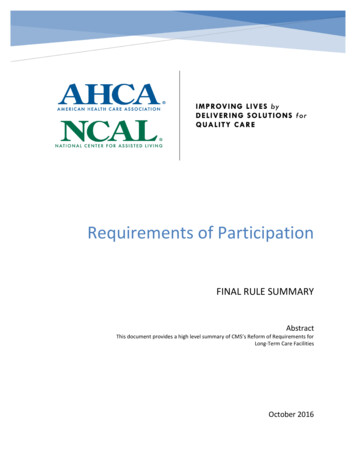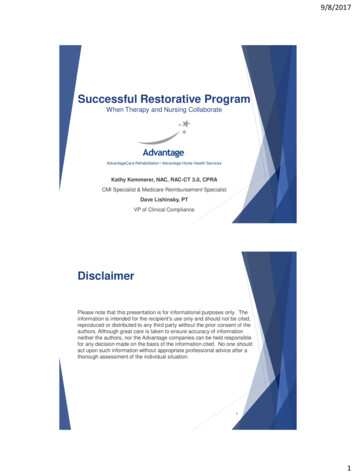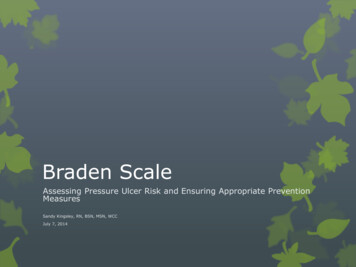
Transcription
Braden ScaleAssessing Pressure Ulcer Risk and Ensuring Appropriate PreventionMeasuresSandy Kingsley, RN, BSN, MSN, WCCJuly 7, 2014
Objectives Identify the 6 subscales comprising the Braden Score Understand how to complete the Braden Scaleaccurately Identify preventative measures and interventionsappropriate to each category of risk Understand the relationship between the driver of riskand the appropriate interventions for the patient relatedto that driver
What is the Braden Scale? Scoring system Evaluates patient’s risk of developing a pressure ulcer Braden Scale – most preferred tool Six categories assessed
Why Assess Pressure Ulcer Risk? Significant problem in older hospitalized adults PU and treatment negatively affect every dimension ofpatient’s life Expensive to treat
Categories Sensory perception Moisture Activity Mobility Nutrition Friction/shear
Sensory Perception 1. Completely Limited Unresponsive Limited ability to feel pain over MOST of body 2. Very Limited Painful stimuli Cannot communicate discomfort Sensory impairment over HALF of body 3. Slightly Limited Verbal commands Cannot always communicate discomfort Sensory Impairment – 1-2 extremities 4. No Impairment Verbal commands No sensory deficit
Moisture 1. Constantly Moist Perspiration, urine, etc. Always 2. Very Moist Often but not always Linen changed at least once per shift 3. Occasionally Moist Extra linen change Q day Rarely Moist Usually dry
Activity 1. Bedfast Never OOB 2. Chairfast Ambulation severely limited to non-existent Cannot bear own weight – assisted to chair 3. Walks Occasionally Short distances daily with or without assistance Majority of time in bed or chair 4. Walks Frequently Outside room 2 x per day Inside room q 2 hours during waking hours
Mobility 1. Completely Immobile Makes no changes in body or extremity position 2. Very Limited Occasional slight changes in position Unable to make frequent/significant changes independently 3. Slightly Limited Frequent slight changes independently 4. No Limitation Major and frequent changes without assistance
Nutrition 1. Very Poor Never eats complete meal/rarely 1/3, 2 or proteins/day NPO, clear liquids, IVs 5 days 2. Probably Inadequate Rarely eats complete meal, approx. 1/2, 3 proteins Occasionally takes dietary supplement Receives less than optimum liquid diet or tube feeding 3. Adequate Eats over 1/2 of most meals, 4 proteins Usually takes a supplement Tube feeding or TPN probably meets nutritional needs 4. Excellent Eats most of meals, never refuses, 4 or more proteins Occasionally eats between meals Does not require supplements
Friction and Shear 1. Problem Moderate to maximum assistance in moving Frequently slides down in bed or chair Spasticity. contractures or agitation leads to almost constantfriction 2. Potential Problem Moves feebly, requires minimum assistance Skin probably slides against sheets, etc. Relatively good position in chair or bed with occasional sliding 3. No Apparent Problem Moves in bed and chair independently Sufficient muscle strength to lift up completely during move Good position in bed or chair
Scoring 19-23 – not at risk 15-18 – preventative interventions 13-14 – moderate risk 10-12 – high risk 6-9 – very high risk
Braden Score 15-18 PreventativeInterventions (At Risk) Regular turning schedule Enable as much activity as possible Protect the heels Use pressure redistribution surfaces Manage moisture, friction and shear Advance to a higher level of risk if other major riskfactors are present
Braden Score 13-14 PreventativeInterventions (Moderate Risk) Use the same protocol as for “at risk” patients Position patient at 30 degree lateral incline using foamwedges
Braden Scale 10-12 PreventativeInterventions (High Risk) Follow the same protocol as for moderate risk In addition to regular turning schedule Make small shifts in their position frequently
Braden Scale 9 or PreventativeInterventions (Very High Risk) Use same protocol as for “high risk” patients Add a pressure redistribution surface for patients withsevere pain or with additional risk factors.
Best Use of Braden Scale Dependent on nurses focus and attention on whichBraden sub-categories are driving the overall risk level. Understanding of all the definitions and scoring rules.
Mr. P; A Case Study Status post fractured left hip with total hip replacement,lives alone Incision dry, intact, no signs of infection and edges wellapproximated Skin assessment on admission and in 24 hours Special attention to heels and sacrum No reddened areas noted Cognitively alert; Pain 8/10 Sensory perception subscale
Case Study Cont’d Perspiring heavily; no evidence of incontinence orwound drainage Moisture subscale Out of bed with assistance and wheeled walker, PT 5 xper week, toe touch weight bearing left leg Activity subscale Mobility subscale Friction and shear subscale
Case Study Cont’d Eating habits at home Banana, coffee for breakfast Cereal for lunch Canned soup and cookies for dinner Normal BMI (23.5) States he has little appetite and often eats only if hefeels like it Does not take a dietary supplement
Braden Score Total Sensory perception 4 Moisture 3 Activity 3 Mobility 2 Nutrition 1 Friction and shear 2TOTAL 15 preventative interventions
Interventions Based on RiskAssessed Heels offloaded Turning and repositioning regularly Encourage as much activity as possible Pressure redistribution surfaces for bed and chair Manage moisture, friction and shear Specific turning sheet Daily inspection of skin with attention to heels andsacrum
Putting the Pieces Together Use interview questions AND physical assessment tocomplete the scale. Include the family and/or caregiver if unable to answerquestions appropriately If in doubt, always give the lower score which willincrease the level of risk Determine the subscale that is driving the highest risk Put interventions in place to address the highest risksubscale as a priority as well as those needed to addressthe level of risk from the other subscales If other risk factors are identified that are not addressedwithin the subscales, implement appropriate strategiesto address them.
2nd Case Study Mrs. C. has had dementia for many years and is nonverbal and does not follow any commands Incontinent of bowel and bladder multiple timesthroughout the day with no indication of awareness No longer able to bear weight. OOB with mechanical liftand 2 assistants. Weight 95 lbs. Height 5’10”; unable to feed herself Skin assessment – stage 1 sacrum, bilateral heels withunstageable areas due to dry, black eschar
Score/InterventionsScoreInterventions TAPS Sensory/perception – 2 Incontinence care Moisture – 2 Weight shifting in chair Activity – 2 Pressure redistributionmattress and cushion Mobility – 1 Nutrition – 1 Friction and shear – 1 Total – 9 – very high risk Heel offloading Dietary consult withdietary interventions/supplementation Turning/pull device
Questions
ReferencesWound Rounds, What is the Braden Scale? s/what-is-the-braden-scale/, WWW May 19,2014.Stotts, N.A., EdD, RN, FAAN, Gunningberg, L., PhD, RN.How to Try This: Predicting Pressure Ulcer Risk. AmericanJournal of Nursing, Nov 2007, 107(11), pgs id 751548,WWW May 19, 2014.
References Revis, D.R., MD. Pressure Ulcers and Wound Care.Medscape Reference Drugs, Diseases & Procedures.Updated March 12, verview
Receives less than optimum liquid diet or tube feeding 3. Adequate Eats over 1/2 of most meals, 4 proteins Usually takes a supplement Tube feeding or TPN probably meets nutritional needs 4. Excellent Eats most of meals, never refuses, 4 or more proteins Occasionally eats between meals Does not require supplements


